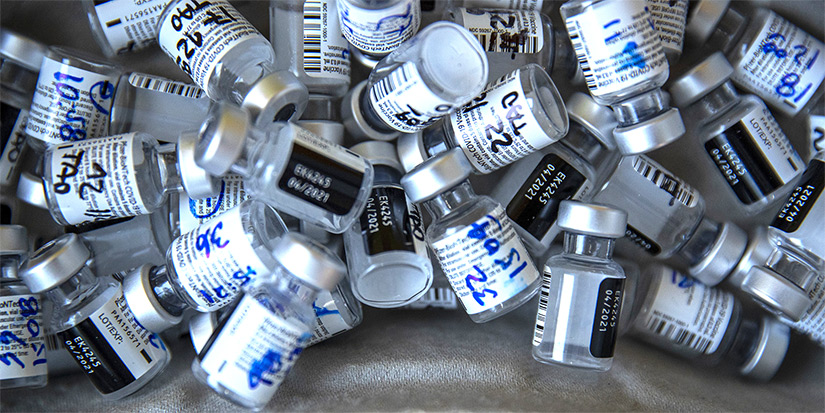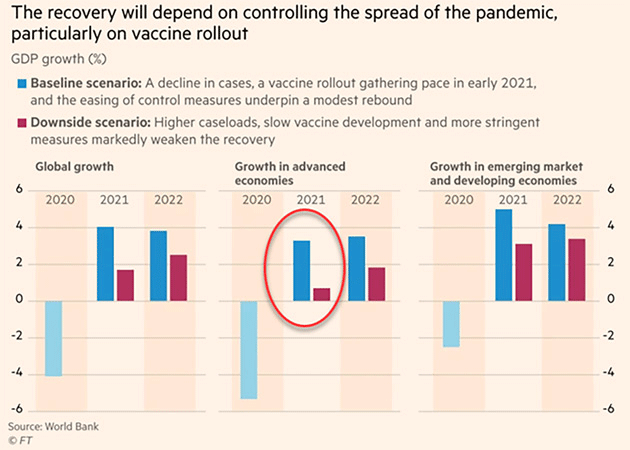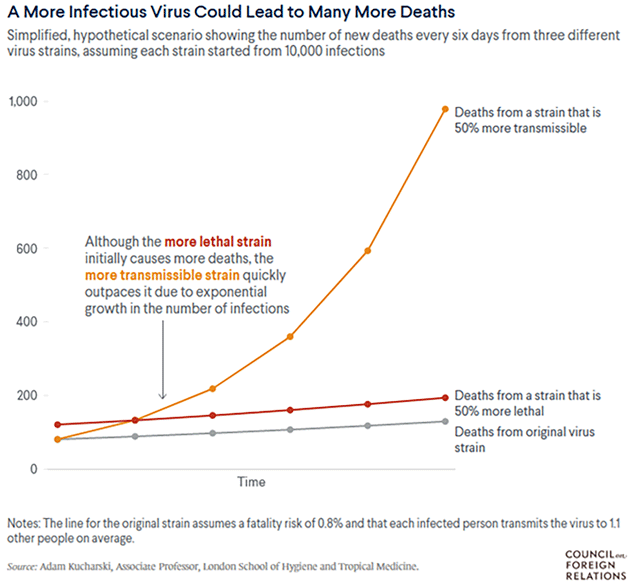The Grip Tightens

This is part two of my 2021 forecast series. I began last week (you can read it here) discussing a three-handed alien race envisioned by science fiction writers Jerry Pournelle and Larry Niven. They had two regular hands and a third “gripping hand,” which though less dexterous, was far stronger. My analogy was that the COVID-19 vaccine has us in the Gripping Hand. Any forecast for 2021 must first consider this decidedly “known unknown.”
Today we’ll begin by looking at new virus developments, some of which are good, some very good, and some frightening. We (the entire world) are in a very tight race with dire consequences if we lose.
Vaccine Race
The one thing we can say with certainty about this year is that the virus outweighs everything else. The economy can grow if we control the virus, or more likely shrink if the virus keeps spreading.
That said, the impact will vary by country, as some seem better at controlling it. But the new UK variant, known as B117 (somehow bringing to mind a World War II bomber), is threatening to upend some previously successful apple carts.
That means, from a global level, growth prospects depend heavily on vaccine success. The World Bank’s annual forecast was very plain about this. It has four scenarios:
- Upside Scenario: Vaccine campaigns proceed swiftly with wide public cooperation, allowing governments to roll back their precautionary measures. Economic uncertainty dissipates and 2021 sees 5% global GDP growth, but a return to prior trend in 2022 with only 1.7% global growth.
- Baseline Scenario: Caseloads fall in major economies as inoculations proceed, with social distancing measures gradually reduced. Economic activity recovers as household consumption returns. In that case, the World Bank expects 4.0% global growth in 2021 and 3.8% in 2022.
- Downside Scenario: Cases remain high as supply bottlenecks and logistical problems slow vaccine deployment. Activity remains depressed as households continue to fear contact-intensive services. Here, it expects global growth of only 1.6% in 2021 and 2.5% in 2022.
- Severe Downside Scenario: As in the downside scenario, the pandemic is difficult to manage and vaccine distribution is slow. The prolonged economic slowdown erodes corporate balance sheets and triggers widespread defaults and concerns for bank balance sheets. It gets worse from there, too. This would give the world economy another year of recession, with global growth somewhere below zero (they are oddly non-specific on this point) in 2021 and bouncing to just 2% in 2022.
The World Bank team also sees a much greater virus economic impact in developed countries, both upside and downside. This is partly because advanced economies are more service-intensive and the pandemic is striking those industries harder. But it’s also because the largest emerging market, China, is bouncing back while the virus has mostly spared Africa, at least so far (though the situation in South Africa is deteriorating quickly).
This handy Financial Times chart summarizes the World Bank’s two midrange scenarios.

The part I circled is its 2021 forecast for advanced economies if vaccines go well (blue bar) or not so well (red bar). The difference is dramatic. Note carefully, these are the two middle scenarios. I think their optimistic scenario, given the latest data, is now sadly unrealistic. We have a nontrivial chance of experiencing the worst case.
However, there is good news, so let’s start there. After a very shaky and mostly slow start, federal and state officials in the US are reorganizing the vaccine rollout. One of the good things about the US federal system is that we can conduct 50 different “laboratory experiments.” In this case, West Virginia and Florida seem to have found better ways. Others are learning from them and the number of people vaccinated should grow quickly in the coming weeks.
Second, I noted last week that we desperately need Johnson & Johnson’s vaccine to be effective and available soon. Without it, we simply won’t have enough vaccine production capacity. This week they reported some initial results that show the vaccine does create antibodies, though that’s not necessarily actual virus immunity. We should see the results of their much larger, 45,000-person Phase 3 trial in late February or March. While the principal trial is a one-dose vaccine, they are also testing a second-dose regimen. We will have to wait for results, but there’s room for optimism.
In the undetermined but encouraging category, many other vaccines are in various trial stages, and we will see results this year. I am following one very closely that could be a game changer not just for the US but the world. It has Defense Department money involved. Logic says we are going to see a lot more of those, simply from the more shots on goal concept, which means we may have many more vaccines available later this year and next year.
Progress is not the same everywhere, though. Below is a graph from my friend Ian Bremmer’s GZERO Media illustrating the different timelines. Note that a significant part of the world stretches into middle or late 2022 and some into 2024. This is clearly a problem for those countries, and we do live in a global world with global trade, which has economic impact everywhere.

More troubling, this allows more time for mutations to develop. Luckily, the UK and South African variants seem to respond to current vaccines but the longer this virus has an opportunity to mutate, the less secure we all are.
As I said above, I expect to see significantly more vaccines this year, and it is important to vaccinate every person who wants a vaccine. The talk of only using one round of the two dose vaccine is extraordinarily dangerous. It is not clear if one dose will be sufficient to provide immunity, and some experts think it could give the virus opportunity to build resistance to the vaccines. I hope the powers-that-be avoid this.
Moreover, we learned as I was finishing this letter that fewer doses are available than thought. This is from a Washington Post report.
When Health and Human Services Secretary Alex Azar announced this week that the federal government would begin releasing coronavirus vaccine doses held in reserve for second shots, no such reserve existed, according to state and federal officials briefed on distribution plans. The Trump administration had already begun shipping out what was available beginning at the end of December, taking second doses directly off the manufacturing line.
Now, health officials across the country who had anticipated their extremely limited vaccine supply as much as doubling beginning next week are confronting the reality that their allocations will not immediately increase, dashing hopes of dramatically expanding eligibility for millions of elderly people and those with high-risk medical conditions. Health officials in some cities and states were informed in recent days about the reality of the situation, while others are still in the dark.
To be absolutely clear, I will receive the vaccine at the first available opportunity. I encourage you to do so, too.
My friend Ben Hunt recently wrote a great piece called “The Ireland Event” which highlights the need to vaccinate as many vulnerable people as possible, as soon as possible. And not just the elderly. There is clear scientific evidence that so-called comorbidities increase the death rate, especially in the younger population. Diabetes, obesity, compromised immune system, etc., make you more vulnerable. If you have any comorbidity, you must be exceptionally careful even if you are young.
Stories about new variants often say they are no more severe, as if that helps. The problem is a faster-spreading virus ultimately is more deadly, simply because it infects many more people, even if the same small percentage of those infected die. Here is the math.

I am not predicting this. But if something like Ben’s “Ireland Event” happens here, it would put the US and probably everyone else in the World Bank’s “severe downside” scenario. That’s why the vaccination efforts need to reach warp speed ASAP. Otherwise, we are going to see more, and perhaps more serious, lockdowns. I am not advocating, I’m simply noting the fact. Note that when Ben says “nontrivial chance,” he means in the 40%-plus category. I am horrified to say this, but I think as business owners and investors we need to consider this scenario a possibility.
More lockdowns mean more economic distress and more small businesses lost, which means the recovery will take longer.
Still, I think the more likely course (and I hope not Pollyannish) is good-but-not-great vaccine progress, allowing us to slowly start normalizing the economy late this year. A lot of things will have to go right. We still don’t know how long immunity lasts, for instance. Our challenge will be much greater if it fades in a year.
Another mystery is how many people unknowingly had mild cases and now possess some immunity even before vaccination. Estimates vary widely. But if it’s a large number, herd immunity effects could begin sooner. That would be extraordinarily economically beneficial, too.
One more distressing note. A new study shows that over a third of hospitalized COVID-19 patients were still experiencing various “neurological reactions” like cognitive deficits, hyposmia, and postural tremor even six months later. Another study from the same article shows that 87% of (emphasis again on hospitalized) patients had at least one lingering symptom. These findings were a “preprint” and haven’t undergone peer review. Still, this is obviously a damn tricky virus, with long-term implications.
My Economic Takeaway
I see better than 60–70% odds that the robust recovery scenarios many see for the latter half of 2021 will prove too optimistic. I desperately hope to be wrong, but restarting 150,000+ small businesses is no trivial matter. Further, all this talk of “pent-up demand,” is unrealistic. People aren’t going to take two vacations when the virus is defeated. Caution will be the rule of the day.
We already see that significant (majority) portions of those receiving the government stimulus checks plan to save them. If an Irish-scale problem (note, I am of Irish descent so I’m not blaming them) reaches the US, a nontrivial chance, it will scar a generation every bit as much as the Great Depression did in the 1930s. We will see higher saving rates and less consumption for years. Given all the other adjustments that COVID-19 has forced upon us, this “recovery” will likely be slower than others, especially given the increasing debt.
That being said, the Biden spending plan should help mitigate the immediate downside. It is not clear how that will all turn out. That’s why I keep emphasizing that COVID-19 has us in the Gripping Hand. Making plans if you are a business, especially a small one, is difficult in this environment.
An Invisible Bright Future and Vaccinations
This week I talked with Fred Maxik, the chief scientific officer of Healthe, to get a progress update on far-UVC lighting. Briefly, this ultraviolet light in the “C” spectrum kills viruses and bacteria (all of them) without hurting humans. The company has made significant progress in developing systems that will be affordable for bars, restaurants, and other small businesses, eliminating (or close to it) the potential for spreading viruses.
They are making progress on an LED version of UVC. By the middle of this decade, this technology could be cheap and ubiquitous. It will eventually be in our homes and offices, on the back of stadium seats and other public venues. This is not just a COVID killer; it stops all viruses and bacteria. Think E. coli or common colds. I would expect shortly after the initial LED solution we will have combination visible light/invisible UVC spectrum light bulbs, too.
This has giant potential for health and wellness. How many people die from infections and viruses each year? Imagine cutting it by well over 90%. That is a game changer for healthcare, not to mention humanity.
This is just one of dozens of technologies that are to change our life this decade. How can I/you/we not be bullish on humanity?
Disclaimer: The Mauldin Economics website, Yield Shark, Thoughts from the Frontline, Patrick Cox’s Tech Digest, Outside the Box, Over My Shoulder, World Money Analyst, Street Freak, Just One ...
more


